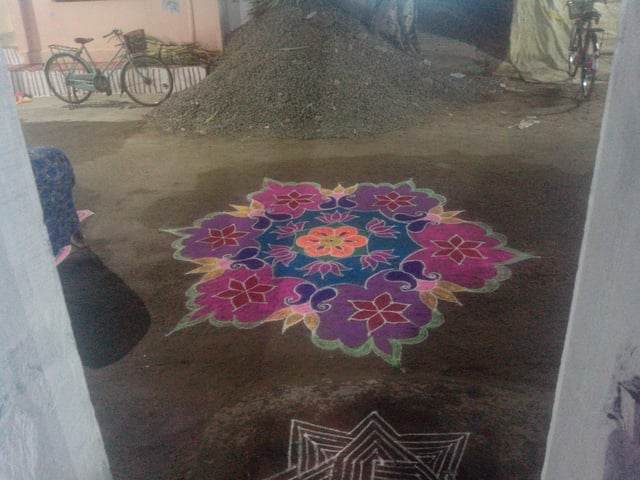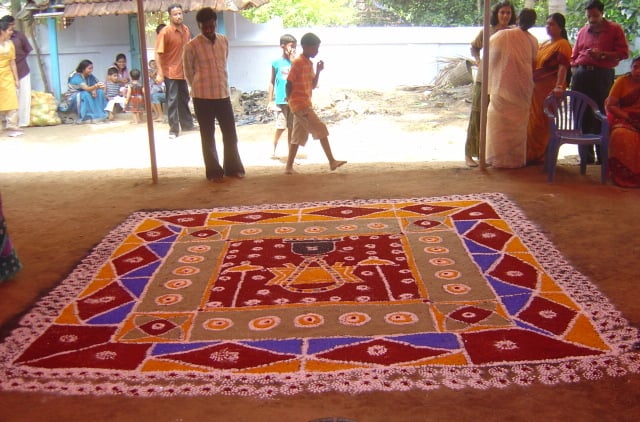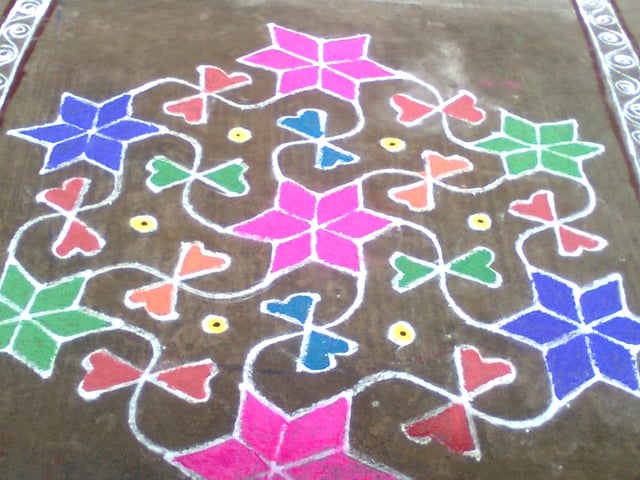Kolam

Kolam


Traditional Agrahara kolam made with soaked rice flour for the festival of Thai Pongal,taken from a house in Singapore

Color in Attur

Pongal Kolam from Chennai, India

Kolam at Andayil Temple, Pudunagaram

Kolam outside a house in Tamil Nadu, India

Sikku (Knot or Twisted) Kolam in front of a house in Tamil Nadu during housewarming
Kolam is a form of drawing that is drawn by using rice flour, chalk, chalk powder or rock powder, often using naturally or synthetically colored powders, in Sri Lanka, the Indian states of Tamil Nadu, Karnataka, Telangana, Andhra Pradesh, Kerala and some parts of Goa, Maharashtra as well as Indonesia, Malaysia, Thailand and a few other Asian countries. A Kolam is a geometrical line drawing composed of curved loops, drawn around a grid pattern of dots. In South India and Sri Lanka, it is widely practised by female Hindu family members in front of their houses.[1] Kolams are regionally known by different names in India, Raangolee in Maharashtra, Aripan in Mithila, Hase and Raongoli in Kannada in Karnataka, Muggulu in Andhra Pradesh and Telangana.[2] More complex Kolams are drawn and colors are often added during holiday occasions and special events.
History

White stones used to make one type of Kolam flour

3x3 symmetry 9 goddesses swastika Kolam with a single cycle by Nagata S, each of which corresponds to one of the nine Devi (Goddesses) of the Vedic system
Kolams are thought to bring prosperity to homes. Every morning in Tamil Nadu, millions of women draw kolams on the ground with white rice flour. Through the day, the drawings get walked on, washed out in the rain, or blown around in the wind; new ones are made the next day. Every morning before sunrise, the floor of the house, or wherever the Kolam may be drawn, is cleaned with water and the muddy floor swept well to create an even surface. The kolams are generally drawn while the surface is still damp so the design will hold better. Even powdered white stone (வெங்கசங்கள் பொடி / மொக்குமாவு) can be used for creating Kolam. Occasionally, cow dung is also used to wax the floors. In some cultures, cow dung is believed to have antiseptic properties and hence provides a literal threshold of protection for the home. It also provides contrast with the white powder.[3]
The decoration is not the main purpose of a Kolam. In olden days, kolams were drawn in coarse rice flour, so the ants would not have to walk too far or too long for a meal. The rice powder also invites birds and other small creatures to eat it, thus welcoming other beings into one's home and everyday life: a daily tribute to harmonious co-existence. It is a sign of invitation to welcome all into the home, not the least of whom is Lakshmi, the Goddess of prosperity and wealth. The patterns range between geometric and mathematical line drawings around a matrix of dots to free form art work and closed shapes. Folklore has evolved to mandate that the lines must be completed so as to symbolically prevent evil spirits from entering the inside of the shapes, and thus are they prevented from entering the inside of the home.
It used to be a matter of pride to be able to draw large complicated patterns without lifting the hand off the floor or standing up in between. The month of Margazhi was eagerly awaited by young women, who would then showcase their skills by covering the entire width of the road with one big kolam.[4]
In the kolam patterns, many designs are derived from magical motifs and abstract designs blended with philosophic and religious motifs which have been mingled together.[5] Motifs may include fish, birds, and other animal images to symbolise the unity of man and beast. The sun, moon and other zodiac symbols were also used.[6] The Downward pointing triangle represented woman; an upward pointing triangle represented man. A circle represented nature while a square represented culture.[7] A lotus represented the womb. A pentagram represented Venus and the five elements.
The ritual kolam patterns created for special occasions such as weddings often stretch all the way down the street. Many of these created patterns have been passed on from generation to generation, from mothers to daughters.
Seasonal messages like welcome (நல்வரவு) can also be used in Kolam. Volunteering to draw the kolam at the temple is sometimes done when a devotee's wishes are fulfilled. The art of Kolam designs has found its way into the future through social networking sites like Facebook. Many Kolam artists have big fan followings online and are playing a role in making the Kolam art form a key part of South India's contemporary art scene.[8]
Variants
Though not as flamboyant as its other Indian contemporary, Rangoli, which is extremely colourful, a South Indian Kolam is all about symmetry, precision, and complexity.[10] Due to their complexity, trying to figure out how, exactly, these designs were drawn can be a challenge that some viewers find enjoyable.
Patterns
a pattern in which a stroke (Neli, Kambi, Sikku in Tamil) runs once around each dot (Pulli), and goes to the beginning point (endless/cycle), as a mostly geometrical figure. The stroke called as Neli from a snaky line. The stroke has Knot (Sikku) structure.[11]
a pattern using only part of the dot grid. If that is the case, the same pattern or a different pattern fills/uses up the remaining dot grids. Most of the times, these patterns together end up becoming a complex pattern.
a pattern in which a stroke runs around each dot not completely, but open.
a pattern in which strokes (Kodu/Kotto) are connected between the dots. Sometimes it represents kinds of objects, flowers, or animals etc.
a pattern in which dots are set in a radial arrangement, called Lotus.
a pattern which is drawn in a freestyle and mostly colourized.
Research
The mathematical properties of Kolam are being used in the computer science field.[10] Kolam patterns are studied and algorithms are developed for regenerating kolam designs with different patterns has been done.[12]
Algorithms for drawing kolams are used in the development of Picture drawing Computer software.[13]
Kolams are used for research in the Computational Anthropology.[14]
As Kolams have a strong relationship with contemporary art and art history, they are used in the artwork and media field.[15]
Kolams are also used to simplify the representation of complex protein structures for easy understanding.[16]
See also
Rangoli
Vanuatu Sand drawing
Street painting
Kuberakolam